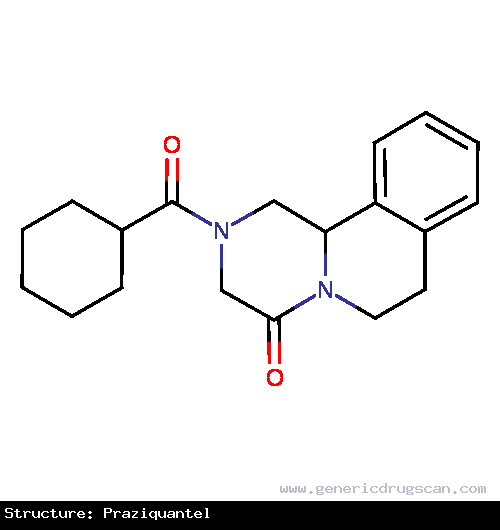Praziquantel Drug: Indication, Dosage, Precaution, Side Effect , Storage, Category Type and corresponding Brands - www.genericdrugscan.com
Praziquantel
Drug Status in USA : ApprovedDrug Status in Canada : Approved
pronunciation
pronounced as (praz'' i kwon' tel)
Why is this medication prescribed?
Praziquantel is used to treat schistosoma (infection with a type of worm that lives in the bloodstream) and liver fluke (infection with a type of worm that lives in or near the liver). Praziquantel is in a class of medications called anthelmintics. It works by killing the worms.
How should this medicine be used?
Praziquantel comes as a tablet to take by mouth with water and a meal. It is usually taken for one day as three doses; each dose spaced 4 to 6 hours apart. Follow the directions on your prescription label carefully, and ask your doctor or pharmacist to explain any part you do not understand. Take praziquantel exactly as directed. Do not take more or less of it or take it more often than prescribed by your doctor.
Praziquantel tablets are marked with 3 notches so that they can easily be split. If your doctor has told you to take only part of a tablet, use your thumbnail to press down on the correct notch and separate the number of parts needed for your dose.
Swallow the tablets or tablet parts whole as soon as you put them into your mouth. Do not chew them, crush them, or hold them in your mouth. The bitter taste of the tablets may cause you to gag or vomit if you keep the tablets in your mouth before swallowing.
What are the precautions to be followed?
Before taking praziquantel,- tell your doctor and pharmacist if you are allergic to praziquantel, any other medications, or any of the ingredients in praziquantel tablets. Ask your pharmacist for a list of the ingredients.
- tell your doctor if you are taking rifampin (Rifadin, Rimactane, in Rifamate, in Rifater). Your doctor will probably tell you not to take praziquantel if you are taking this medication. Your doctor will probably tell you to stop taking rifampin four weeks before beginning treatment with praziquantel, and will tell you to start taking rifampin again one day after finishing treatment with praziquantel.
- tell your doctor and pharmacist what other prescription and nonprescription medications, vitamins, nutritional supplements, and herbal products you are taking or plan to take. Be sure to mention any of the following: chloroquine (Aralen); cimetidine (Tagamet); dexamethasone (Decadron, Dexpak); erythromycin (E.E.S., E-Mycin, Erythrocin); itraconazole (Sporanox); ketoconazole (Nizoral); and certain medications for seizures such as phenytoin (Dilantin), phenobarbital, and carbamazepine (Equetro, Tegretol). Your doctor may need to change the doses of your medications or monitor you carefully for side effects. Many other medications may also interact with praziquantel, so be sure to tell your doctor about all the medications you are taking, even those that do not appear on this list.
- tell your doctor if you have ocular cysticercosis (infestation with a type of tapeworm that forms cysts in the eyes)Your doctor will probably tell you not to take praziquantel.
- tell your doctor if you have or have ever had seizures; cysticercosis nodules (bumps) just under your skin; or kidney, liver,or heart disease.
- tell your doctor if you are pregnant or plan to become pregnant. If you become pregnant while taking praziquantel, call your doctor.
- do not breastfeed on the day you take praziquantel and for 72 hours (3 days) after you take praziquantel.
- you should know that praziquantel may make you drowsy. Do not drive a car or operate machinery on the day you take praziquantel and the day after you take praziquantel.
What are possible side effects of this medication ?
Praziquantel may cause side effects. Tell your doctor if any of these symptoms are severe or do not go away:- not feeling well
- headache
- dizziness
- stomach pain
- nausea
- fever
- itching
- hives
Praziquantel may cause other side effects. Call your doctor if you have any unusual problems while taking this medication.
How to store the medication and dispose it of after its use later?
Keep this medication in the container it came in, tightly closed, and out of reach of children. Store it at room temperature and away from excess heat and moisture (not in the bathroom). Throw away any medication that is outdated or no longer needed. Talk to your pharmacist about the proper disposal of your medication.
Drug Category/Class
- Quinoline Derivatives and Related Substances
- Antitrematodals
- CYP2D6 Inducers
- CYP2D6 Inducers (strong)
- Cytochrome P-450 CYP1A2 Inhibitors
- Cytochrome P-450 CYP1A2 Inducers
- Cytochrome P-450 CYP2C19 Inducers
- CYP3A4 Inhibitors
- Anthelmintics
- Antiparasitic Products, Insecticides and Repellents
- Quinoline derivatives and related substances
| Prescribed | For the treatment of infections due to all species of schistosoma. |
| Weight : | 312.4061 |
| Structure | Praziquantel |
 | |
| Formula | C19H24N2O2 |
Praziquantel has 7 Brands listed
| Cest (600 mg) | Cysticide (500 mg) |
| Distoside (600 mg) | Helminthex (50 mg) |
| Prazine (600 mg) | Praziquantel (600 mg) |
| Prazisan (600 mg) |
Search Generic Drugs alphabetically
